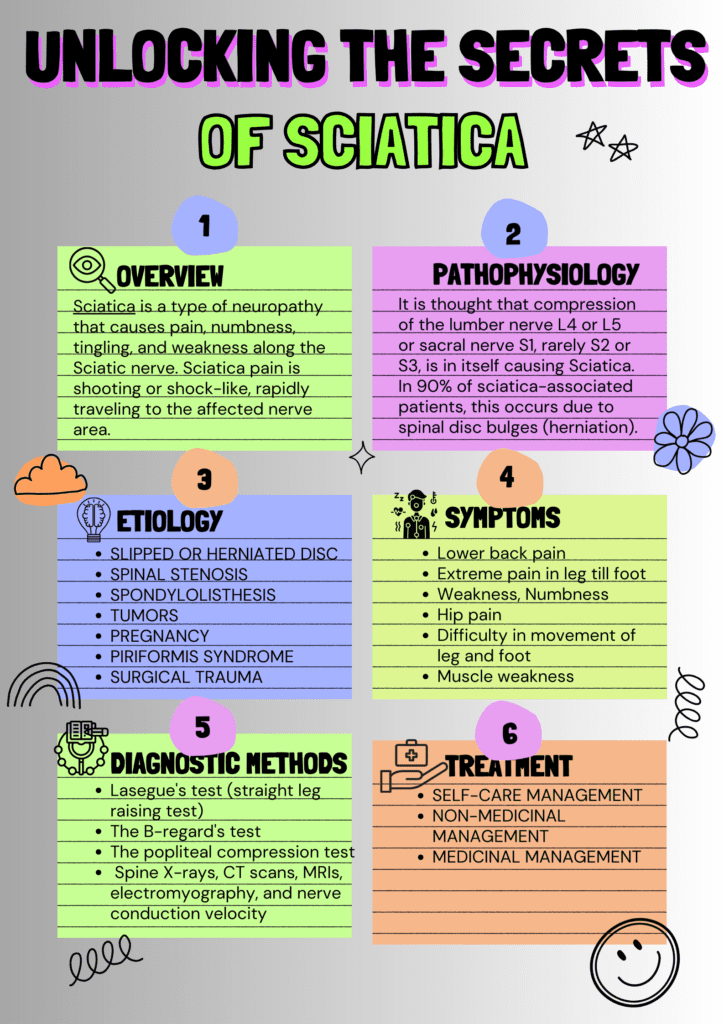INTRODUCTION TO SCIATICA:
Sciatica is a type of neuropathy that describes pain, numbness, tingling, and weakness along the Sciatic nerve. It usually defines a symptom rather than a condition or disease. Sciatica pain usually starts from the lower back, mainly the buttock or hip region, and radiates down the whole leg. And sometimes way into the foot.
Sciatica pain is shooting or shock-like, rapidly traveling to the affected nerve area. The onset of the pain is sudden following activities like heavy lifting and improper body posture, but sometimes, there is a gradual onset of the condition.
ANATOMICAL FEATURES OF SCIATICA NERVE:

The sciatic nerve contributes direct motor innervation to the hamstrings and lower extremity adductors and indirect motor innervation to the calf muscles, anterior lower leg muscles, and some intrinsic foot muscles.
The sciatic nerve is two individual nerves bundled together in the same connective tissue sheath – the tibial and common fibular nerves. These are separate at the apex of the popliteal fossa. However, approximately 12% of people separate as they leave the pelvis.
PATHOPHYSIOLOGY OF SCIATICA:
It is thought that compression of the lumber nerve L4 or L5 or sacral nerve S1, rarely S2 or S3, is in itself causing Sciatica. In 90% of sciatica-associated patients, this occurs due to spinal disc bulges (herniation).
CAUSES ASSOCIATED WITH SCIATICA NERVE PAIN:
Sciatica begins when there is any pressure or damage to the sciatic nerve. Common causes of Sciatica pain include:
SLIPPED OR HERNIATED DISC:
SPINAL STENOSIS:
This is another compressive spinal canal condition (the space from which the spinal cord runs) that becomes narrow and compresses the spinal cord, sciatica nerves, or cauda equina (a bundle of spinal nerves and spinal nerve rootlets), which passes through it. The resulting narrowing condition causes bone spur, inflammation, or herniated disc, which again reduces the area for the spinal cord that can cause sciatica nerve pain.
SPONDYLOLISTHESIS:
This is the slippage of one vertebral segment concerning the next vertebral segment with mechanical symptoms or pain. It is graded based on the slippage of one vertebral body on the adjacent vertebral body. The etiological factors can be acquired, congenital, or idiopathic. It is also a cause of Sciatica itself.
TUMORS:
PIRIFORMIS SYNDROME:
PREGNANCY:
IATROGENIC:
It includes direct surgical trauma, improper position during anesthesia for any operation, injection of neurotoxic agents, dressings, casts, or faulty fitting orthotics that lead to sciatic nerve compression.
SYMPTOMS:
Significant symptoms of Sciatica include:
· Lower back pain.
· Extreme pain in leg till foot, which is aggravated when sitting.
· The nature of pain is electric shock, which suddenly radiates to the entire leg.
· Hip pain
· A sudden shooting pain which is unable to stand up.
· weakness, numbness
· Difficulty in movement of leg and foot.
· Muscle weakness
· Sometimes, in very severe cases, there is urinary or fecal incontinence
DIAGNOSTIC METHODS:
Sciatica is commonly diagnosed through:
· Patient history includes the nature of pain, duration, intensity, and aggravation.
· Healthcare providers always look for some diagnostic tests beneficial in evaluating Sciatica. It usually includes Lasegue’s test (straight leg raising test). The SLR is considered positive when it induces radiating pain with the course of the sciatic nerve and below the knee between 30 and 70 degrees of hip flexion.
.The b -regard’s test is a modification of the SLR, where ankle dorsiflexion is applied at the end of the SLR. Dorsiflexion minimizes the SLR angle at which the test is positive and can be used to modify neural symptoms from musculoskeletal symptoms.
· The popliteal compression test or posterior tibial nerve stretch sign. The patient can be examined in a sitting or prone position. The examiner flexes the knee and applies pressure on the popliteal fossa, evoking Sciatica.
· Spine X-rays, CT scans, MRIs, electromyography, and nerve conduction velocity studies help evaluate the condition.
SCIATICA TREATMENT:
Sciatic pain can be treated with various therapies to return the patient’s normal functional status and quality of life.
· SELF-CARE MANAGEMENT:
These are helpful measures, and you can take these practices at home, including cold or heat packs; bed rest is not recommended.
Back exercises under the supervision of an expert are recommended to ease your back. Minimize your activities in the first couple of days and slowly restore to your normal activities.
Avoid heavy lifting or bending your back for the first six weeks when pain begins.
· NON-MEDICINAL MANAGEMENT:
The application of a cold or heat pack depends upon the length of the symptoms, stretching activities, use of counter medications such as NSAIDS (non-steroidal anti-inflammatory drugs) like ibuprofen naproxen, well as the use of acetaminophen to those who are allergic to NSAIDS.
Use of muscle relaxant medication, along with the practice of alternative therapies like acupuncture.
Physiotherapy is also very useful in this regard. A physiotherapist who is an expert in this area has a variety of exercises that help restore the patient’s painful condition. It includes stretching exercises and low-impact activities, including walking and swimming.

%20(1)-min.png)
1 thought on ““Unlocking the Secrets of Sciatica: Understanding The Painful Mystery!””